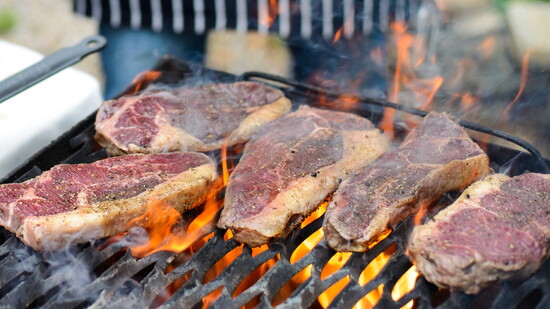This time of year, you’ll be hard-pressed to drive through any Minnesota neighborhood without catching the familiar scents of summer. No, not suntan lotion and fresh-cut grass; we’re talking the unmistakable aroma of charred meats and sizzling success. When looking to up your grilling game, especially with steak, you need tips from a professional who knows the meat inside and out – literally. Someone who understands quality and cuts and has a passion for the process. You need a family-owned and operated local farm, Gongoll Beef, and you need Dave Gongoll.
Gongoll Beef, a third-generation farm located in Mayer, sets itself apart from other local producers in many ways, but what stands out most is the quality of its product. “When we get a steer, they weigh about 100-120 pounds, and right away, we put them on corn,” Dave shares. With this nutrient-dense corn diet, along with a little hay on the side, Gongoll Beef’s Angus cattle gain about 100 pounds a month and turn out some of the tastiest meat you’ll find in the Midwest. How will you know? “When a steer eats corn its entire life, you’ll find white marbling ingrained and evenly distributed throughout the meat, not just along the edges.” And that marbling is the fat that gives it its rich flavor, melt-in-your-mouth texture, and irresistible juiciness.
Alsleben Meats, the butcher that Gongoll Beef works with exclusively, also takes the extra step of hanging the beef carcass for two weeks. This allows natural enzymes responsible for breaking down tough connective tissue to act, resulting in more tender meat. Imagine the scene in Rocky when Balboa does a bit of training in the meat locker. That—minus the struggling, small-town boxer.
When a Friday night calls for steaks on the grill at Dave’s house, his cut of choice is a T-bone, sliced an inch and a quarter thick. “Cooking with a bone adds a lot of flavor, and this thickness makes it easier to get medium rare, which is the juiciest.” And if you think the reddish liquid that seeps out of a medium-rare steak is blood, think again. It’s actually a mix of water and myoglobin – a protein that stores and carries oxygen and gives the meat its color and richness.
Dave’s Directions on How to Make the Perfect Steak
Now that you know what’s behind the robust, mouthwatering flavor of Gongoll Beef, Dave happily shares his simple yet masterful grilling process, and he’s got it down to a science.
- Dave thaws his steaks in the refrigerator overnight.
- When the apron’s on and he’s ready to fire up the barbecue, he lets the meat come to room temperature and seasons it with nothing more than salt and pepper.
- With the grill heated to 500 degrees, he cooks one side for 2 minutes and 45 seconds, flips it for another 2 minutes and 10 seconds, and then lets it rest for exactly 15 minutes. “Any more than that,” he says, “and you’re eating it cold!”
Dave wholeheartedly believes it takes all the key players — farmer, butcher, and top-tier Angus — combining forces to achieve gourmet greatness. With Gongoll Beef, the way each of these contributors performs ensures you’ll never have to break the cardinal rule that all farmers live by: Thou shall never use A.1. Sauce on a steak. Because with Gongoll Beef, you simply won’t need it.
Dave's cut of choice is a T-bone sliced an inch and a quarter thick. 'Cooking with a bone adds a lot of flavor, and this thickness makes it easier to get medium rare, which is the juiciest.'
